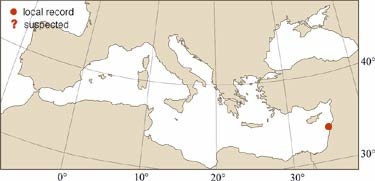
|
Relevant Synonyms
Misidentification
|
|
| drawing: Tuvia Kurz |
|
SHORT
DESCRIPTION
color :
whitish with an irregular pattern of dark brown flames and mottles, interrupted on the spiral row of knobs.
common size :
12-20 mm. |
DISTINGUISHING CHARACTERISTICS
BIOLOGY / ECOLOGY
habitat :
in the Indo-Pacific, this species lives in sand pockets of intertidal or very shallow pools of rocky shores. |
|
1st
Mediterranean record
|

|
|
DISTRIBUTION
|
ESTABLISHMENT SUCCESS
speculated reasons for success :
|
|
|
MODE OF
INTRODUCTION |
IMPORTANCE TO
HUMANS |
|
KEY
REFERENCES
|
|
|